Getting a cab is usually not a problem in Asia – in most cities they are everywhere and easily found at public taxi stands, hotels and airports.
But it is often after you have entered one when problems begin. Service is inconsistent from one country to another. The cabbie might even suddenly ask for more – that’s if you actually get to where you want to go.
Another common phenomenon in the region is taxi touting at airports. Some illegal “taxi drivers” rent vehicles for a day and offer to chauffeur you to town for a jacked up flat rate. The lure is being able to skip the queue and hop right into a taxi, but the price is usually not worth it – not to mention the lack of security in using an unregistered cab.
So bring this guide with you before you hail a cab, and arm yourself with the knowledge of taxi types, rates and legal issues, in 10 cities within the region.
BANGKOK
Taxis are the most prevalent mode of transportation in Bangkok, but they are not without issues. Many drivers don’t speak English so be sure that you have someone write down in Thai where you want to go, or have your concierge on speed-dial.
OPTIONS Most of the taxis seen in the city are two-toned colour. Blue-and-red cabs belong to the Nakornchai Taxi Radio Network while yellow-and-green cabs are privately owned. Both types of taxis charge the same fare. Licensed taxis are recognisable by the “Taxi Meter” sign on the roof and the yellow-and-black licence number plate. Of course, there are also the famous tuk tuk and the motorbike taxis, with which you have to negotiate fares. The two-wheeled rides are popular at rush hour as they can easily navigate between vehicles stuck in the city’s infamous traffic jams. But be warned: they are considered unsafe. Taxis are still recommended.
FARES The starting fare for metered taxis should be THB35 (US$1.17) and remain so for the first kilometre travelled. You might, at times, encounter cab drivers asking for a flat rate. Not only is it illegal for them to do so, the rate asked is usually double or triple the normal fare. Simply decline and get another cab. The metre increases by THB5 (US$0.17) per km from two to 12km, THB5.5 (US$0.18) from 12 to 20km, THB6 (US$0.20) from 20 to 40km and THB8.5 (US$0.28) from 40 to 60km. When stuck in traffic or when the speed drops to below 6km/h, the metre jumps up THB1.25. (US$0.04) per minute. There is also a surcharge of THB50 (US$1.67) on top of the metre fare for travellers taking a cab from the airport.
NOTE Some cabbies in Bangkok are known to coerce passengers from overseas to go to gem factories or other places from which they presumably get commissions. Be firm and just say no.
HONG KONG
This Special Administrative Region of China broadly consists of Hong Kong Island, Kowloon Peninsula and the New Territories. The first two are where most of the urbanised areas are located, and the latter also includes the 200-plus outlying islands, and among them only a handful have vehicle traffic. Taxi drivers in the city, especially in major districts, usually speak enough English to do their jobs.
OPTIONS Different taxis serve these various districts in Hong Kong. The most common being red urban taxis which are the most expensive and can operate in most areas: Hong Kong, Kowloon, the New Territories, and Tung Chung town, the airport and Disneyland on Lantau – the largest outlying island. Green taxis are used for travelling within the less urbanised New Territories, and blue taxis operate only on Lantau.
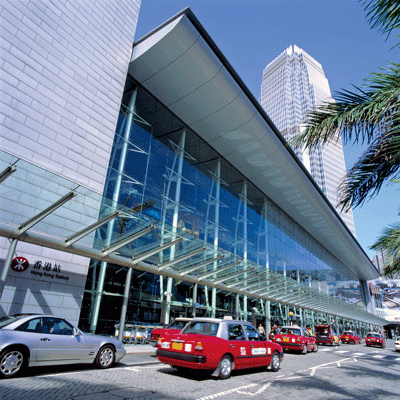
FARES The metre starts at HK$18 (US$2.32) in red cabs, HK$14.50 ($1.87) in green cabs and HK$13 (US$1.68) in blue cabs and remain so for the first 2km of the journey. Each subsequent 200m adds HK$1.50 (US$0.19) to the metre on red cabs, and HK$1.30 (US$0.17) on green and blue ones.
There is a surcharge of HK$5 (US$0.64) for each piece of luggage, animal or bird and telephone booking made for red and blue taxis, and HK$4 (US$0.52) for green taxis. There are various tunnels in Hong Kong, and the ones that you are most likely to use are the three for crossing the harbour. Passengers are responsible for paying the tolls, which range from HK$10 (US$1.29) to HK$45 (US$5.81), and the return toll of either HK$10 (US$1.29) or HK$15 (US$1.94), depending which tunnel is taken. Return toll is not required if you get a taxi at a designated cross-order tunnel taxi stand and for other tunnels. To go to the airport, there is a HK$30 (US$3.87) surcharge for the Lantau Link in addition to tunnel fees.
NOTE Taxi drivers in Hong Kong are mostly law abiding, but some do try to cheat. Luckily, the city also has a competent and efficient police force. Call +852 2527 7177 if you’re in any dispute with a taxi driver.
JAKARTA
OPTIONS There are quite a number of taxi companies in this city, but the Blue Bird Group is locally known as the most reliable and safe.
Blue Bird offers two kinds of taxis, the regular Blue Bird Taxi and the Silver Bird taxi, which is a luxurious, executive line of cabs equipped with Global Positioning System (GPS) devices and Electronic Data Capture (EDC) for electronic payment with credit or debit cards.
FARES A regular Blue Bird taxi costs IDR6,000 (US$0.67) for the first kilometre and IDR300 for every subsequent kilometre. In slow moving or stationary traffic, the metre will run at IDR30,000 (US$3.36) per hour.
For an executive Silver Bird taxi, there are two tiers, the Mercedes C Class and the Toyota Alphard or Mercedes E Class. The flag-down rate for the Mercedes C Class is IDR12,000 (US$1.68) and IDR5,500 (US$0.84) is added to the metre for each kilometre after the first. The corresponding costs on a Mercedes E Class and Toyata Alphard are IDR15,000 (US$1.68) and IDR7,500 (US$0.84). Waiting time for all Silver Bird cars costs IDR60,000 (US$6.71) per hour.
Blue Bird taxis can be flagged down at just about anywhere in Jakarta, but Silver Bird taxis are generally found at hotels and the airport.
NOTE Taxis in Jakarta have no surcharges but be cautious and check that the metre is on and reset when you enter a cab. Sometimes passengers may be unaware that drivers haven’t reset the metre and end up paying extra.
KUALA LUMPUR
OPTIONS One common taxi you will encounter is from Sunlight Taxi, which offers two kinds of cabs: budget and premier.
FARES Budget taxis charge RM3 (US$0.97) for the first kilometre and RM0.10 (US$0.03) for every kilometre after. In slow moving or stationary traffic, the first three minutes will cost RM3 (US$0.97) and thereafter RM0.10 (US$0.03) per 21 seconds. Premier taxis charge RM4 (US$1.29) for the first two km and RM 0.20 (US$0.06) for every 200 metres after. In slow moving or stationary traffic, the first two minutes cost RM4 (US$1.29) and every 45 seconds after that adds RM0.20 (US$0.06) to the tally.
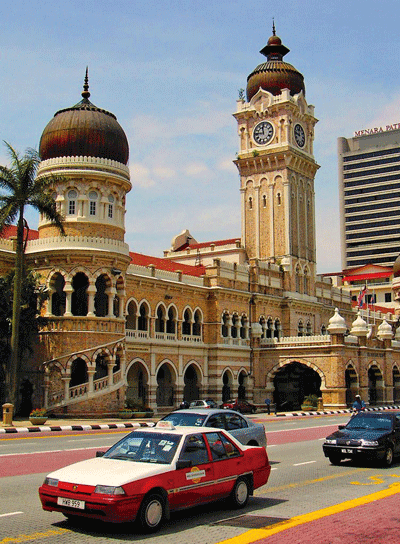
There is a surcharge of RM2 (US$0.64) for budget taxis, and RM1 (US$0.32) for premier taxis for using radio-call service, and a RM12 surcharge for both types of cabs when travelling to Kuala Lumpur International Airport. Premier taxis charge an additional RM1 (US$0.32) for storing luggage in the trunk.
NOTE Apart from hailing or calling a cab, there is a taxi voucher system where you go to an officially designated counter, tell the clerk where you want to go and obtain a voucher for the amount you’re supposed to pay. You only need to pass the voucher to the driver for him to claim the money after you have arrived at your desired destination. This system has been put in place for tourists to safeguard them from being cheated into paying jacked up fares.
Taxi voucher counters are available at Kuala Lumpur Sentral, Kuala Lumpur International Airport (KLIA) and certain tourist spots and malls.
Do note that at KLIA, a taxi voucher is a must if you wish to take a cab from the airport. The airport has a dedicated line of taxis operated by Airport Limo that will only accept passengers with a taxi voucher. All other taxis that do not require vouchers are illegal.
MANILA
OPTIONS With over 20 taxi operators in Manila, you probably can never be short of a cab. Larger operators include MGE and EMP.
FARES The flag down rate is PHP30 (US$0.69) and every 300 metres after the first 500 metres, the metre increases by PHP2.5 (US$0.0574).
Additionally, most four- or five-star hotels are tied up with taxi companies such as Click to provide guests with private taxis. These hotel taxis do not have metres installed and customers pay a premium to use them. However, they are deemed safer than street taxis as hotels have the personal details of the cabs and the drivers.
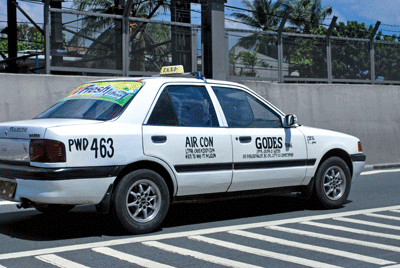
NOTE Make sure the metre is switched on when you enter a regular cab. Having small change handy is also important, as some cabbies will claim they do not have change and “force” you into leaving tips. In such cases, ask to be driven to a nearby store to break your note. The cabbie might suddenly “recall” where he has put his small change.
MUMBAI
OPTIONS There are three types of cabs in this busy Maharashtra capital, first being rickshaws, three-wheeled open-air taxis which you can flag down for INR10 (US$0.23), second being black cabs that charge a starting rate of INR16 (US$0.36) and lastly the light blue Meru cabs which are the most reliable of the three.
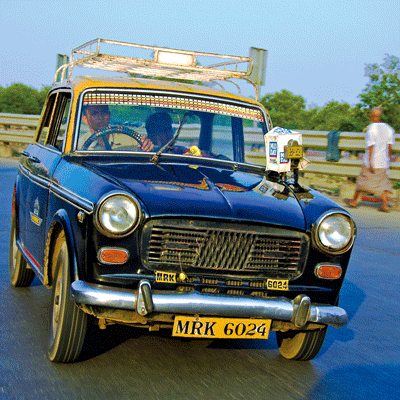
FARES Meru cabs are fixed with digital tamper-proof metres and charge travellers a flag down fare of INR22 (US$0.50). Each subsequent kilometre after the first costs INR15 (US$0.34). The metre will continue to run at INR0.50 (US$0.01) when the cab is stationary and there is a 25 percent surcharge from 11pm to 5am.
NOTE Rickshaws are the most commonly used of all the taxis but their low fares also come with compromised service. Some drivers may refuse to take you to your destination if it’s only a short distance away.
SEOUL
OPTIONS If you know the name of the place you are going to in Korean, you would have no problem with a standard Ilban Taxi (silver grey). These are the most common and cheapest cabs in Seoul. There are also black Moberm (Luxury) Taxis with yellow light sign, which cost about twice as much as an Ilban Taxi but are more comfortable and provide a higher standard of service. But taxi drivers in both of these options speak little or no English.
If you’d feel more comfortable with a driver who can communicate with you, there are International Taxis that can be booked on the phone and you can ask for a driver proficient in English, Mandarin or Japanese. They are either black or orange, with signs in various languages on the bonnet, doors or/and roof lamps as identification. There is also an option of nine-passenger vehicles for bigger groups.
Some taxis have the sign “Free Interpretation” on them and they offer free interpretation service in Japanese, English and Chinese through cell phones. Simply tell your cab driver: “Free interpretation”.
FARES Ilban Taxis cost KRW2,400 (US$2.15) for the first 2km and increase by KRW100 (US$0.09) with every additional 144 metres thereafter. Bear in mind, though, that there is a 20 percent surcharge between midnight and 4am.
For Moberm Taxis, the starting fare is KRW4,500 (US$4.03) for the first 3km and KRW200 (US$0.18) is added to the metre with every 164 metres thereafter.
When travelling in an International Taxi, passengers have a choice between the taxi metre fare system or a taxi charter fare. The taxi metre fare system has a flag down rate of KRW2,880 (US$2.58) for medium-size taxis and KRW4,500 (US$4.07) for large ones. In a medium-size taxi, the minimum fare increases by KRW120 (US$0.11) every 144 metres after the first 2km and whenever the car moves at a speed slower than 15km/h for 35 seconds. In large taxis, the fare jumps by KRW200 (US$0.18) every 164 metres after the first 3km or every 39 seconds travelling at a speed slower than 15km/h.
For the taxi charter fare, passengers can charter a cab for a specific number of hours starting at KRW50,000 (US$44.75) for three hours to KRW400,000 (US$358.04) for the entire day.
When travelling from the airport, however, a flat fare of either KRW55,000 (US$49.23), KRW65,000 (US$58.18) or KRW75,000 (US$67.13) is charged, depending on which area of Seoul you are travelling to.
SHANGHAI
OPTIONS There are an estimated 45,000 taxis operated by 150 taxi companies in Shanghai. Different colours demarcate different cab companies such as the cyan Dazhong taxis, yellow Qiansheng taxis and white Jinjiang taxis but by and large they offer the same service.
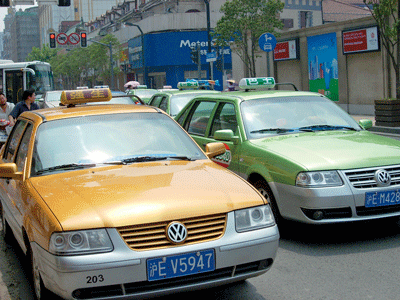
FARES The fare starts at CNY12 (US$1.80) for the first three km and increases by CNY2.4 (US$0.36) with each additional kilometre within 10km and CNY3.6 (US$0.54) for each kilometre past 10km.
Between 11pm and 5am the flag down rate is CNY16 (US$2.39) for the first 3km. The metre rises by CNY3.1 (US$0.46) for every subsequent kilometre within 10km and CNY4.7 (US$0.70) for every subsequent kilometre after 10km.
In traffic, five minutes of waiting time is the equivalent of travelling one kilometre.
NOTE To know when a cab is vacant, look out for a small disk with the Mandarin characters “kong che” on the dashboard. When the disk is illuminated and upright, it means the car is available. All licensed cabs have a logo on the roof, a metre and a vacancy disk on the dashboard. If a cab is missing any of these, it is best to avoid it.
SINGAPORE
OPTIONS There are seven companies, 29 types of taxis and over 25,600 units serving the tiny island, the most common being the yellow City Cab and blue Comfort Taxi.
FARES The flag down rate varies from S$2.80 (US$2.16) for a normal cab to S$5 (US$3.86) for a premier Chrysler 300c taxi. With every 385 metres travelled up to 10km and every 330 metres travelled after 10km, the metre jumps by S$0.20 (US$0.15). The same charge applies to every 45 seconds of waiting.
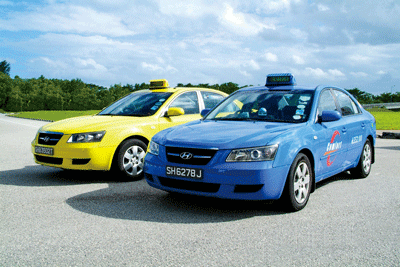
The cab system in Singapore is peppered with surcharges. Travelling on weekdays between 7am and 9.30am and on weekdays and Saturdays between 5pm and 8pm will set you back by an additional 35 percent of the metered fare; while travelling between midnight and 5.59am will cost one and a half times the metered fare.
Apart from time of day, location from where you take a taxi also matters. Hailing a cab in the central business district between 5pm and midnight from Monday to Saturday will result in an extra S$3 (US$2.32) on top of the peak hour surcharge. Taking a taxi from Changi Airport will cost you an extra S$3 (US$2.32) to S$5 ($US3.86).
TOKYO
OPTIONS Like Shanghai, cabs in Tokyo come in various colours, each one representing a certain cab company. The more common city cabs are the orange Tokyo Musen taxis and Green Taxis found at taxi stands, hotels, Narita International Airport and generally on the street.
FARES The majority of taxi metres start at ¥710 (US$8.70) and remain so for the first 2km. The amount increases by ¥80 (US$0.98) with every 274 metres travelled or for every two minutes in slow moving or stationary traffic.
There is a night surcharge when travelling between 11pm and 5am, where 30 percent of the metered fare is added on.
NOTE English isn’t commonly spoken by taxi drivers in Japan. Make sure that you have someone write down the name and address of the place you need to go to. When looking for a taxi, take note of the light at the windscreen. A green light means the cab is available for hire, while a red light means the taxi is on call or taken. n
Fast Facts
Bangkok
Nakornchai Taxi Radio Network: +66 2 878 9000
Hong Kong
Hong Kong Taxi Centre: +852 2574 7311
Jakarta
Blue Bird Regular Taxi: +62 21 7917 1234/794 1234
Blue Bird Executive Taxi: +62 21 798 1234
Manila
EMP: +63 2 293 59 60
MGE: +63 2 364 82 60
Mumbai
Meru Cabs: +91 22 4422 4422
Seoul
For Ilban taxis call:
Kind Call: +82 2 1588 3382
N Call: +86 2 1688 2255
S Taxi: +82 2 1577 0115
Moberm Taxis: +82 2 3431 5100
International Taxi: +82 2 1644 2255
Shanghai
Jinjiang: +86 21 96961
Qiangsheng: +86 21 6258 0000
Dazhong: +86 21 96822
Singapore
Comfort and City Cab: +65 6522 1111
Tokyo
Tokyo Musen: +81 3 3330 2111
Green : +81 3 3203 8181








